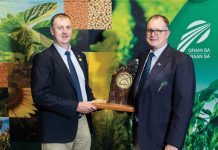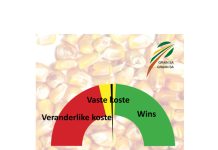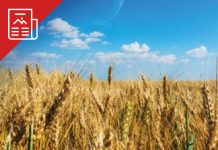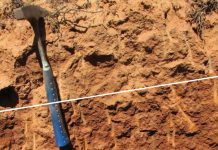


Spikelets and seed.

Scientific name: Amaranthus hybridus
Afrikaans name: Gewone misbredie
English name: Common pigweed
Short description
Common pigweed is an erect, multi-branched, hairless, annual herbaceous plant. It can grow up to 90 cm long, but much higher in suptropical conditions. The stems are green to brown and sometimes it is redly tinged and strongly ribbed. The leaves ae simple, alternately arranged and broad lancet shaped. It can be up to 6 cm long and 3 cm wide. The margins of the leaves can be entire and the veins are more distinct on the lower surface of the leaf. Leaf stalks can sometimes be as long as 5 cm. Flowers are borne in dense terminal and axillary spikes and are unisexual, with male flowers at the top of the spike and the more numerous female flowers at the bottom. The flowers are straw-coloured. Fruits of common pigweed are small bladder-like fruits, that are dehisced by lids. The seeds are small, shiny, dark brown to black and lens-shaped.
Distribution
Common pigweed is one of the most abundant and widely distributed broadleaved weeds of cultivated fields in southern Africa. Common pigweed occur in both summer- and winterrainfall areas of South Africa.
Control
Cultivation
Common pigweed is easy to control with shallow cultivation when the weed is still in the seedling stage.
Chemical
Various pre- and post-emergence broadleaf herbicides can be used to control common pigweed effectively (Tables 1 and 2).
TABLE 1: Broadleaved herbicides registered for use on maize for the control of common pigweed.
| Active ingredient | Formula | Time of application |
|---|---|---|
| 2,4-D | 480 g/litre | Pre-emergence application five to six days after plant. Post-emergence when crop is 30 cm tall, otherwise use drop-arms for directed spray |
| 2,4-D/dicamba | 240/80 g/litre | Post-emergence when weeds are actively growing, five to six leaf stage |
| acetochlor/atrazine/simazine | 160/165/165 g/litre | Pre-emergence with or just after planting |
| acetochlor/atrazine/terbuthylazine | 125/187,5/87,5 g/litre 150/225/225 g/litre 200/150/150 g/litre 250/225/225 g/litre 350/175/175 g/litre | Pre-emergence with plant or within three days after planting. Early post-emergence, not later than four leaf stage of the weed |
| atrazine | 500 g/litre 900 g/kg | Pre-emergence on well-prepared seedbed Early post-emergence, two leaf stage of the weed |
| atrazine/cyanazine | 167/333 g/litre 250/250 g/litre | Pre-emergence or early post-emergence |
| atrazine/mesotrione/s-metolachlor | 208,5/26,8/208,5 g/litre | Pre-emergence application |
| atrazine/metazachlor/terbuthylazine | 210/60/210 g/litre | Pre-emergence, within three days after planting. Can be followed-up with an early post-emergence application |
| atrazine/metolachlor | 300/300 g/litre | Pre-emergence application within three days after planting |
| atrazine/metolachlor/terbuthylazine | 174/252/174 g/litre | Pre-emergence or early post-emergence, before weed reaches four leaf stage |
| atrazine/s-metolachlor | 370/290 g/litre | Pre-emergence application just after planting |
| atrazine/s-metolachlor/terbuthylazine | 262,5/175/262,5 g/litre | Pre-emergence application |
| atrazine/sulcotrione | 300/125 g/litre | Pre- or early post-emergence application |
| atrazine/terbuthylazine | 250/250 g/litre 270/270 g/litre 300/300 g/litre 450/450 g/kg | Pre-emergence or post-emergence before four leaf stage of the weed |
| atrazine/terbutryn | 250/250 g/litre | Pre-emergence with planting or just after planting |
| bendioxide | 480 g/litre | Post-emergence application |
| bromoxynil | 225 g/litre 400 g/litre 450 g/litre 500 g/litre | Post-emergence, four to six leaf stage of the weed |
| bromoxynil/terbuthylazine | 150/333 g/litre | Post-emergence |
| dicamba | 480 g/litre 700 g/kg | Post-emergence, before crop reaches 30 cm |
| dicamba/tropamezone | 160/50 g/litre | Early post-emergence, before six leaf stage, use in tank mixture with atrazine or atrazine/terbuthylazine |
| EPTC | 720 g/kg 200 g/litre | Pre-plant, incorporated into soil,consult product label |
| flumetsulam | 800 g/kg | Pre-emergence, use in tank mixture with metolachlor or s-metolachlor |
| flumetsulam/s-metolachlor | 20/630 g/litre | Applied with planting or within three days after plant |
| glyphosate/mesotrione/s-metolachlor | 250/25/250 g/litre | Post-emergence, only on glyphosate tolerant cultivars |
| halosulfuron | 750 g/kg | Post-emergence |
| linuron | 500 g/litre | Post-emergence as a directed spray, when weeds are between 50 cm - 75 cm tall and crops are between 35 cm - 50 cm tall |
| MCPA | 400 g/litre 700 g/kg | Pre-emergence, within five to six days after plant. Post-emergence till crop is 30 cm tall |
| mesotrione | 480 g/litre | Pre- or post-emergence. Use only in tank mixture with atrazine, atrazine/terbuthylazine or s-metolachlor |
| mesotrione/s-metolachlor | 83,3/416,7 | Pre-emergence |
| s-metolachlor/terbuthylazine | 102,8/497,2 g/litre 312,5/187,5 g/litre | Pre-emergence Pre-emergence, in tank mixture with mesotrione |
| metribuzine | 480 g/litre | Post-emergence, between four to six leaf stage of weed, in tank mixture with 2,4-D or bromoxynil |
| pyraflufen-ethyl | 20 g/litre | Post-emergence, when weed is between two to four leaf stage. Use only in tank mixture with MCPA or bromoxynil |
| tembotrione/isoxadifen-ethyl | 420/120 g/litre | Post-emergence in tank mixture with atrazine |
| terbuthylazine | 500 g/litre | Post-emergence application with 2,4-D/dicamba |
| trifluralin | 480 g/litre | Pre-plant application |
| tropamezone | 336 g/litre | Early post-emergence, before six leaf stage, use in tank mixture with atrazine or atrazine/terbuthylazine |
Table 2: Broadleaved herbicides registered for the control of common pigweed in wheat.
| Active ingredient | Formula | Time of application |
|---|---|---|
| 2,4-D | 480 g/litre | Apply at growth stage seven to 13 of the wheat |
| 2,4-DB | 400 g/litre | Undersowed lucerne in grain crops, wheat must be between leaf stage five and full tillering, READ THE LABEL |
| 2,4-D/dicamba | 240/80 g/litre | Apply at growth stage seven to 13 of the wheat |
| bendioxide | 480 g/litre | Apply on young, actively growing weeds |
| bromoxynil | 225 g/litre 400 g/litre 450 g/litre 500 g/litre | Weeds must be fully germinated, but not older than six leaf stage. Wheat seedlings should be between the three leaf and end of booting stage |
| chlorsulfuron/metsulfuron-methyl | 375/300 g/kg | Weed in leaf stage three to four |
| dicamba | 700 g/kg | Only to be used in a tank mix with Enhancer (10 - 12 g) + Reaper (10 g) + adjuvant |
| halosulfuron | 750 g/kg | In mixtures (see label) |
| fluroxypyr/triclopyr | 240/120 g/litre | Weed in leaf stage two to eight |
| MCPA | 400 g/litre 700 g/kg | Apply at growth stage seven to 13 of the wheat |
| pyraflufen-ethyl | 20 g/litre | Post-emergence, when weed is between two to four leaf stage. Use only in tank mixture with MCPA or bromoxyni |
| trifluralin | 480 g/litre | Before planting |
Contact the writers at elbe.hugo@syngenta.com (Elbe Hugo) and deweth@arc.agric.za (Hestia Nienaber).

















